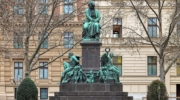Europa Nostra supports UK campaign to safeguard rare mural by Hungarian artist Mayer-Marton in Oldham Church, Fitton Hill
Europa Nostra UK, together with Europa Nostra, the European Voice of Civil Society committed to Cultural Heritage, support the campaign by SAVE Britain’s Heritage to safeguard by listing this internationally significant mural. The mural, by Hungarian artist George Mayer-Marton, entitled ‘The Crucifixion’, is an unusual combination of mosaic and painted fresco completed in 1955 in Oldham’s Church of the Holy Rosary.
Listing is justified by:
1. The international significance of the work because of the artist, its era and technique, as a synthesis of European cultural experiences and expression – the dislocation of migrants and the cross-fertilisation of ideas and experimentation of material techniques;
2. Its survival in situ in the setting for which it was created is now almost unique in the UK, and that the work is intact and capable of being conserved; and
3. That the work in its setting is at tangible real risk from vandalism or damage by being in a disused building, and because the owners have publicly stated their intention to remove the mural from the setting for which it was created (introducing the additional risk of damage caused by ill-judged removal).
This is only one of only two ecclesiastical murals by Mayer-Marton that survive in situ, and it is the only one that incorporates both fresco and mosaic. The Byzantine mosaic method Mayer-Marton employed is believed to be its first use in this country. The significance of the mural has been highlighted by a number of national experts including the Twentieth Century Society, the Ceramic and Architectural Tiles Association as well as several leading academics and architectural historians. This is not only an important piece of UK heritage but also European heritage as it is a rare survival of the work of this renowned Hungarian artist and of his immigrant creative community genre.
We support SAVE Britain’s Heritage’s initiative and the campaign by the descendant of the artist, urging the listing of the mural, followed by the conservation of the mural back to its original condition. We understand there have been two independent expert conservators’ reports which confirm that the recent ‘domestic’ overpainting can be successfully removed and the original restored.
Sara Crofts, Chair of Europa Nostra UK, sees the mural in its European context: “The UK is home to unique heritage born out of our close relationship with our European neighbours. Artists from Europe have shaped the cultural landscape and produce incredible works of art such as ‘The Crucifixion’ by George Mayer-Marton. This rare survival needs urgent protection and support for restoration. Europa Nostra UK welcomes SAVE Britain’s Heritage campaign and will seek further support from Europa Nostra members to raise awareness of it.”
Sneška Quaedvlieg-Mihailović, Secretary General of Europa Nostra, backs up Europa Nostra UK’s position: “To sever the link between artwork and setting would go against everything that defines our European cultural heritage, rendering the artwork a displaced migrant like its artist during a time of enforced upheaval. But we are in a time of peace, so we appeal to the Diocese to appreciate the symbolic and artistic value of what they have, and we appeal to see this artwork listed to give it the recognition and protection its unique European story deserves.”
Note for Editors
Mayer-Marton (born Hungary 1897, died Liverpool 1960) was a leading figure in the Viennese art world in the 1920s and 1930s. He and his wife escaped to Britain in 1938, where he began working as a lecturer for CEMA, the predecessor of Arts Council. In 1952 he was appointed as a lecturer at the Liverpool College of Art. There he established the Department of Mural Art. The course in this technique which he instigated at the College was the first of its kind in the UK. During his time at the college Mayer-Marton completed more than 200 oil paintings and he was commissioned by the Roman Catholic Church to carry out works at a number of churches in Lancashire and Cheshire, completing numerous frescoes and mosaics, one of which, the Pentecost, now resides in the Metropolitan Church of Christ the King in Liverpool.
Europa Nostra is the European voice of civil society committed to safeguarding and promoting cultural and natural heritage. A pan-European federation of heritage NGOs, supported by a wide network of public bodies, private companies and individuals, it covers more than 40 countries. Founded in 1963, it is today recognised as the largest and the most representative heritage network in Europe.
Europa Nostra campaigns to save Europe’s endangered monuments, sites and landscapes, in particular through the 7 Most Endangered programme. It celebrates excellence through the European Heritage Awards / Europa Nostra Awards. Europa Nostra actively contributes to the definition and implementation of European strategies and policies related to heritage, through a participatory dialogue with European Institutions and the coordination of the European Heritage Alliance 3.3.
Europa Nostra UK is a UK-based charity that supports Europa Nostra.







